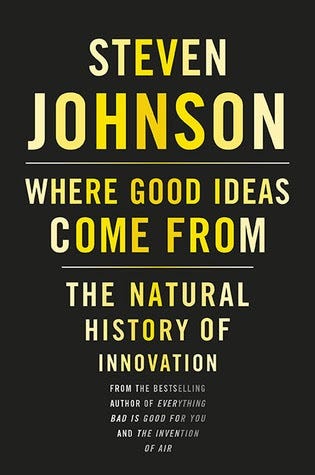🌀🗞 The FLUX Review, Ep. 30
December 2nd, 2021
Episode 30 — December 2nd, 2021 — Available at read.fluxcollective.org/p/30
Contributors to this issue: Neel Mehta, Justin Quimby, Boris Smus, Ben Mathes, Erika Rice Scherpelz, Spencer Pitman, Alex Komoroske, Dimitri Glazkov
Additional insights from: Stefano Mazzocchi, Ade Oshineye, Gordon Brander, a.r. Routh, Robinson Eaton
We’re a ragtag band of systems thinkers who have been dedicating our early mornings to finding new lenses to help you make sense of the complex world we live in. This newsletter is a collection of patterns we’ve noticed in recent weeks.
“The major difference between a thing that might go wrong and a thing that cannot possibly go wrong is that when a thing that cannot possibly go wrong goes wrong it usually turns out to be impossible to get at or repair.”
— Douglas Adams
♨️💥 Look for the forces, not the friction
An impact — bang! Your head whips around; you look to the source. A flaming car skids down the road. We’re drawn to the action. We see the damage. But to understand the bigger picture and its cause, we have to understand the underlying forces. What happened? Who did what? Why? The visible outcomes — the areas of friction — are just the byproducts. To understand and build solutions, look to the forces, not just the friction.
We see this play out in organizational bureaucracy. People tend to complain about labyrinthine approval processes and command-and-control leadership, but it’s harder to see the underlying conditions that cause this.
In one large enterprise-tech company, the average process time to provision a server was 6 months. People complained about the number of approval steps (29!). To get anything done, people directly addressed the friction by requesting frequent process exceptions. To avoid the process entirely, teams hoarded server capacity. All attention was on the friction. But what were the underlying forces at play?
The company found that regulatory pressure incentivized complicated processes to create logs for regulatory audits. With this force made clear, the company invited regulators in, improved the process, and automated about 85% of the approval work. By comparison, addressing only the friction had created more work when the massive amount of exceptions had to be explained to regulators!
The problem persisted because people focused on the personal impact of the process friction. Looking at the systemic forces revealed the need for capacity on demand and the need to address regulatory concerns. By looking at and designing for both forces, the firm was able to reduce process time while increasing auditability (turns out regulators like logs generated by machines more than by humans).
Look for the forces that lead to the friction. Seeing the underlying forces can create an opportunity to shift from mediocre bandages to more fundamental and impactful changes. Even when change isn’t possible, it can at least lead to a better understanding of why things are the way they are.
🛣️🚩 Signposts
Clues that point to where our changing world might lead us.
🚏🧫 Scientists created tiny, living, programmable “robots” that can reproduce
Scientists discovered that, when they clumped frog stem cells in a particular way and placed them on a tray full of loose cells, these blobs could start swimming around and even reproducing. The Pac-Man shaped blobs gobble up cells, compress them, and spit out new baby blobs. These clumps are classified as robots because they’re crudely programmable: their starting shape determines their behaviors, and they can be sort of 3D-printed from computer models. Researchers say this breakthrough could help us advance regenerative medicine, improve our ability to control robot swarms, and even understand the potential origins of life on Earth.
🚏🇮🇳 India’s fertility rate has fallen below replacement level
India looks on track to one day become the planet’s most populous country, but it’s also hit a significant milestone in its demographic transition. The country’s total fertility rate, which measures the average number of children born to a woman over her lifetime, has long been declining and has now hit 2.0 — which is just less than the replacement rate of 2.1. Without in-migration, then, India’s population will eventually begin to fall.
🚏💸 The Omicron cryptocurrency’s price grew 10x after the new COVID variant was named
The Omicron ($OMIC) cryptocurrency is the native coin of OmicronDAO, a month-old DeFi project that’s a fork of the popular OlympusDAO project. When the World Health Organization named the new “omicron” strain of COVID-19, meme investors across the internet stampeded into the $OMIC coin, briefly raising the price 10-fold. Said one investor who bought $40,000 worth of the coin: “I don't think it's a good choice, but I'm willing to gamble meme with some money that doesn't affect my life.”
🚏🚜 A fertilizer shortage is raising concerns about food price spikes in North America
Soaring prices for natural gas, a key ingredient in nitrogen-based fertilizer, have led to a shortage of said fertilizer, with the price up at least 80% since last year. Experts worry that there won’t be enough fertilizer to go around when next spring’s planting season arrives, which could lead to further increases in already-high food prices.
🚏🖼 A video game company will let fans sell art and merch without telling the company
The makers of the popular game Genshin Impact have heavily relaxed their rules around fan creations. Per newly-announced rules, fans will be able to sell Genshin-based fan fiction stories for profit without having to tell the company at all; they’ll also be able to sell up to 500 units of physical merchandise like dolls and fan art without getting approval. While this company isn’t the first company to give fans such freedom to monetize, it’s rare that the permission is given so explicitly.
🚏🛒 The UK wants Meta to unwind an acquisition, a first for the regulator
The UK’s Competition and Markets Authority (CMA) is ordering Meta (formerly Facebook) to sell off Giphy, a GIF-sharing website that the company bought last year, saying that the purchase “could reduce competition between social media platforms and increase Facebook’s already significant market power.” It’s the first time the regulator has called for an undoing of an acquisition, and it looks like it won’t be the last — the CMA is now scrutinizing several other high-profile tech acquisitions of recent years.
🚏🚷 The US government banned the purchase of some NFTs
The US government has put 57 Ethereum addresses on a sanctions list for taking part in money laundering and ransomware activities; US-based crypto users and crypto trading platforms are no longer legally allowed to do business with those addresses. One of those addresses owns 42 NFTs, and because one of the most popular NFT trading platforms (OpenSea) is US-based, OpenSea has banned the purchase of those NFTs on its website.
📖⏳ Worth your time
Some especially insightful pieces we’ve read, watched, and listened to recently.
XML, Blockchains, and the Strange Shapes of Progress (apenwarr) — Argues that blockchains’ impacts on finance can be compared to XML’s attempt to reform HTML: it’s not very successful at serving its stated purpose, but it’s driven a lot of investment in interoperability, and the booming energy has driven the ecosystem forward.
The Teenager Economy (Margins) — Argues that public markets, the US government, and the media don’t keep companies honest or discipline them for making bad choices; without adults in the room, many startups (including those in crypto) have felt empowered to stretch the truth, act recklessly, and otherwise act like “moody, rebellious teenagers.”
The Decider (NOBL) — A useful website and Slackbot that helps teams figure out the best decision-making process for their situation. Describes 8 processes (such as “consent”, “democratic”, and “stochastic”) whose effectiveness varies based on parameters like the situation’s urgency, the concentration of expertise, the team’s candor, and more.
The “Lying Flat” Movement Standing in the Way of China’s Innovation Drive (Brookings) — Details how Chinese youths have grown burnt-out from the government’s relentless push of grueling “996” work schedules and rampant consumerism, both intended to grow the Chinese economy. Without any way to actively protest, these disaffected youths are passively resisting by opting out of an economic system that they feel leaves them stagnant and exploited.
‘Buy the Constitution’ Aftermath (Vice) — Reports on the tumult that has engulfed the ConstitutionDAO project after it narrowly lost its bid to buy a copy of the US Constitution. Observes that, ironically, much of the unrest has come from the group’s leaders not asking the community what they want to do with the money (in violation of the DAO’s supposedly-democratic principles) and the high gas fees wiping out small-time donors’ contributions (which made crypto a poor crowdfunding vehicle in this case).
It’s Time to Stop Demonizing “Invasive” Species (Vox) — Argues that the popular notion of “invasive species” leads us to a one-dimensional view of the world: one of “good” pristine ecosystems disrupted by “bad” invaders. But in a world where climate change is disrupting every ecosystem, species are being forced out of their previously-native ranges, and humans are moving species around without their consent, the moral question of which species “deserve” to live somewhere has gotten a lot murkier.
We Should Design Businesses Like Circles, Not Straight Lines (Quartz) — IDEO’s CEO argues that the traditional, linear economic model of the industrial age (make–use–dispose) is environmentally unsustainable, and that we should instead design circular business models that promote reusing goods, repurposing products, and taking advantage of idle capacity.
📚🌲 Book for your shelf
An evergreen book that will help you dip your toes into systems thinking.
This week, we recommend Where Good Ideas Come From by Steven Johnson (2010, 326 pages).
Where Good Ideas Come From rebuts common notions about the process of innovation, exchanging them for other compelling models for how it actually happens.
Innovation occurs at the edge of possibility. If you’re not bold enough, it’s already been done. Too bold and you’re ahead of your time. Johnson rejects the narrative of the “eureka” moment. Success comes through slow hunches, which brew slowly in a person’s mind. He also rejects the idea of a solo inventor working in a vacuum. In a liquid network, multiple slow hunches have a good chance of meeting. Innovation often comes when an insightful person combines multiple hunches into a coherent idea. Johnson encourages the cross-pollination of ideas and a multidisciplinary approach.
Biological evolution relies on exaptation, where an old adaptation is suddenly used for a different purpose. Innovation does the same: Gutenberg’s printing press borrowed the screw press mechanism used for pressing olives into oil and grapes into wine. By creating spaces that foster intellectual diversity, we catalyze the exaptation of ideas.
Packed with examples, quotes, and readable prose, Johnson’s book pushes back at some of the myths about innovation while providing a model for how to innovate successfully.
🕵️♀️📆 Lens of the week
Introducing new ways to see the world and new tools to add to your mental arsenal.
This week’s lens: Plan Voisin.
Look at this code base! It’s messy. It’s complicated. The sheer amount of technical debt is soul-crushing. What are we to do? If you’re tempted to start a new project, to create a clean slate to learn from the past and do better, you are in good company.
A similar intention was behind Le Corbusier’s Plan Voisin. Aiming to solve the problems of overcrowding and sanitation caused by the outdated infrastructure of Paris’s slums, the famous architect presented a utopian design of 18 cross-shaped skyscrapers in vast green parks, aiming to accommodate millions of residents. The audacious project never made it past initial approvals. It’s unlikely that Le Corbusier’s solution to housing inequity would have been successful. Constructing a perfect city from scratch rarely works. There are just too many unexpected twists and turns when humans live together. Whether in code or buildings, our ideals and architectural genius rarely withstand the test of time.
Despite our best efforts, the beautiful new things diverge from our well-laid plans and grow barnacles. We believe that we’re wiping away dirt and filth, but there might be value in this mess. Even if that is not true in aggregate, it may be true for individuals who have learned to thrive in the current system.
And yet clean slate ideas can have influence beyond their actual success. Though never implemented, Plan Voisin has found its way into the urban landscape, inspiring housing skyscraper developments all over the world — for better and worse.
Next time you hear the siren song of a clean slate, try the Plan Voisin as a lens. How right will you need to get this to actually create the value you’re expecting? How big of a change would it have to be? Who might be resistant to that change? And who might it inspire even if you don’t succeed?
🔮📬 Postcard from the future
A ‘what if’ piece of speculative fiction about a possible future that could result from the systemic forces changing our world.
// What happens in a world where imagery that some people would rather have forgotten gets put into an immutable blockchain?
// 2031. A private IRC channel.
<Mnemosyne> Thanks for reaching out to ForgetMe.eth. First, allow me to summarize the situation as we understand it. There are several GIFs and videos that you would like removed from the blockchain, but as such the traditional “right to be forgotten” approaches will not work. You are willing to pay our fee as per our previous conversation upon completion, so long as you remain anonymous. Is this correct?
<Samuel> yes.
<Mnemosyne> Wonderful. If you would drop the initial deposit into address `0xF046...31DC`, along with the blockchain addresses of the images in question, we can begin.
[The next day]
<Mnemosyne> Status update: many of the images were hosted via older NFT systems that relied on traditional URL encoding, meaning we simply need to penetrate those systems to alter the underlying images. We’re using next-gen deepfake tech to alter the subjects of the images. The problem is that for targets 34, 38, and 92, the images are embedded directly into the blockchain. We are now deploying distributed agents to seize control of the controlling wallets, and cryptoburn them to render them illegible.
<Samuel> wonderful, thank you!
[A separate channel]
<Mnemosyne_Internal> Heh, the honey pot landed another one. This customer wanted to burn some images of him doing some... awful stuff, which crossed our moral line. Deepfake analysis shows that it's actually him, rather than a frame-up job. Info is attached. Happy hunting.
<M.Smith> Excellent.






